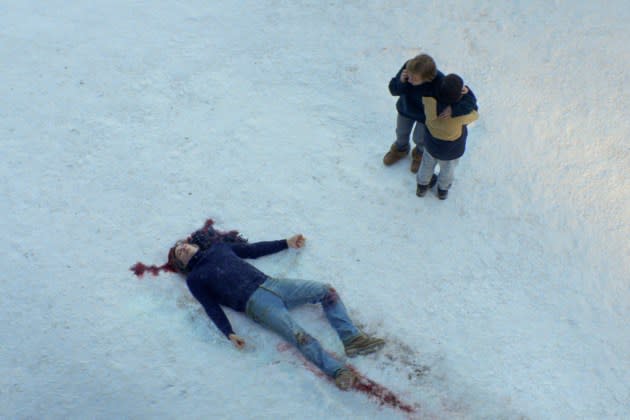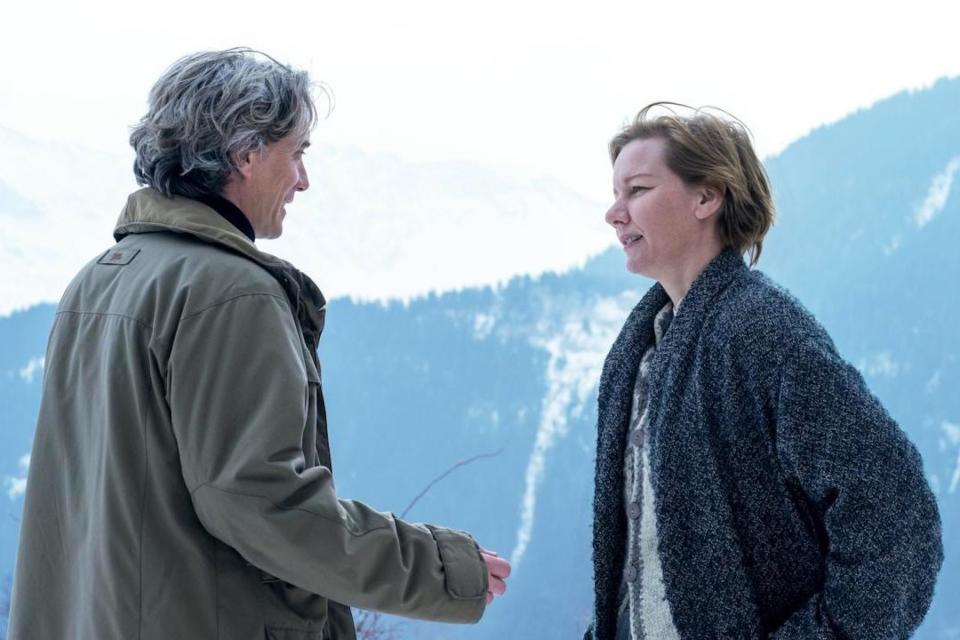‘Anatomy of a Fall’ Is the Year’s Most Gripping Murder Mystery

Anatomy of a Fall starts out with an extraordinary act of passive-aggressiveness: A German writer, Sandra Voyter (Sandra Hüller) is sitting in her home in Grenoble, a part-cabin, part-winter-getaway mini-mansion tucked away at the snowy foot of the French Alps. She’s being interviewed by a female student (Camille Rutherford) about her work. Wine’s being consumed, questions lead to slightly flirty answers and queries about the young woman’s life. The vibe feels like it’s slowly drifting into intimate territory. Sandra’s son, Daniel (Milo Machado-Graner), is roaming around with his Border Collie, Snoop; an accident several years before has left him sight-impaired, but he knows both the place and the area outside like the back of his hand. You could easily describe the scene as cozy.
And then you hear it: A cacophony of steel drums and rumbling beats. Anyone within a five-mile radius could probably hear it, given how deafeningly loud it’s being blasted throughout the house. The song — it’s an instrumental version of 50 Cent’s “P.I.M.P.” — plays, ends, and then kicks right back in again, a perpetual eardrum-shattering loop of manufactured tropical cheer. The interviewer is confused. It’s my husband, Sandra explains. He’s up in the attic, and likes to listen to music while he works. She doesn’t seem particularly perturbed by it, nor does she appear to be pleased. You get the sense that this kind of acting out happens a lot.
More from Rolling Stone
When a Man Vanishes in a Town of 11 People and Everyone's a Suspect
'The Caine Mutiny Court-Martial' Is the Perfect Ending to William Friedkin's Career
Finally, after straining to hear each other, they ixnay the interview and the student leaves. On her way out, she sees Daniel and Snoop leaving for a walk. When the boy and his dog return home, the music is still shaking the rafters. Only the man who’d turned the volume up to 11 is lying in front of the house, dead. After Daniel screams, Sandra rushes out, hugs her son, and calls the authorities. What they would like to know is: Did he plummet out of the open window on the fourth floor by accident, or was he pushed?
That’s the burning question writer-director Justine Triet uses to fuel this sly take on courtroom dramas and crime procedurals… or at least, that what she wants you to think is the big dilemma that doubles as the engine of her film. What the French filmmaker and her co-writer Arthur Harari are actually chasing here ends up being slightly more covert, and far, far more compelling. The issue here isn’t necessarily whether Sandra killed her husband and is trying to conceal the crime, though that’s definitely what her lawyer (Swann Arlaud), a prosecuting attorney (Antoine Reinartz), and the nation’s judicial system would like to know. After all, it’s not every day that a famous writer is accused of murdering her spouse. Not even in France!
No, what Triet is doing is performing an autopsy on a relationship that, once upon a time, started as a heated romance for a twentysomething couple before responsibilities, resentments, compromises, tragedy, and time slowly asphyxiated it to death. There’s most certainly a homicide at the center of Anatomy of a Fall, but it doesn’t necessarily stop or start with that body on the ground. This is a movie about the killing of a matrimonial union curdled by bitterness and unsaid broken promises. Shortly after this film premiered at Cannes, where it deservedly won the Palme d’Or, a colleague described it as “Marriage Story but as a thriller.” And though some may come for the murder mystery, it’s Triet’s way of using that genre to get at deeper notions of love turning to hate, and tiny marital fissures that turn into chasms, that really makes this something close to an anti-romantic masterpiece.
The suspicions that Samuel (Samuel Theis), a.k.a. Sandra’s late spouse, perished due to something more sinister than bad luck start early, especially once inconsistencies start showing up in both her and Daniel’s stories. A bruise on her arm is blamed on bumping into the kitchen counter, then is revealed to be from an altercation with her husband. The partially blind tween says that he was outside before his mother and father had a “discussion” shortly before his fall, then thinks he may have misremembered his location due to shock. We find out that Samuel forced the family to move back to his hometown so he could focus on his writing, despite the fact that Sandra was happy in London; that he blames himself for the accident that took most of Daniel’s sight; that Sandra has had a number of affairs with both men and women, which drove Samuel crazy; and that she “borrowed” a key plot point from her husband’s abandoned novel for her own work, which then became a rousing success.

More incriminating details about possible suicide attempts and petty jealousies that metastasized into dealbreakers are also dragged out in court, much to Sandra’s dismay. She was simply standing up for what she believed she deserved. Those who believe this independent woman is guilty — and oddly enough, most of these naysayers are men — think her behavior may have been too “castrating” for her soulmate. An interesting choice of words. Then comes the film’s centerpiece, courtesy of a last-minute piece of evidence: a recorded argument between the couple found on a USB drive. The scene switches from audio of Sandra and Samuel discussing his need for more space and time to work to a present-tense perspective of what happened in that living room, a day or so before his death. And the way this duet builds to a crescendo of accusations, deflections, projections, and painful attempts to wound the other combatant is partially why that earlier Marriage Story comparison is well-earned, even if Anatomy is singular in how it lays out this virtuosic display of verbal flaying so that both parties leave scarred.
(This showstopping sequence also confirms what many of us already knew, or least highly suspected, which is that Sandra Hüller is one of those once-in-a-generation screen actors that can navigate both beaucoup verbiage — in three languages, no less! — and volatile emotional terrain with the grace of a prima ballerina. The whole thing becomes a lesson on how to give your sparring partner the right amount of rope to figuratively hang themselves. She keeps you guessing as to whether Sandra’s traumatized state of mind is a put-on or not, as well as portraying this mother as both nurturing and possibly calculating regarding her son’s lack of certainty about what happened. It’s one of those performances that, like Hüller’s work in Requiem (2006) and Toni Erdmann (2016), consistently has you leaning in to witness what she may do next. Add this turn to her exquisitely bone-chilling work in Jonathan Glazer’s Holocaust drama The Zone of Interest, and you have Exhibits A and B as to why 2023 is Hüller’s year.)
Triet isn’t interested in casting aspersions one way or another; she simply wants to give us scenes from a marriage and let us sift through the wreckage. The verdict is almost beside the point. And unlike the meta-melodramatics of her previous work, Sibyl (2019), there’s no ribbing or winking here. Instead, Anatomy of a Fall delivers a series of thrusts, parries, and other countermoves that chronicles the ways in which even the best of relationships can start to rot from the inside out. You may exit the theater personally wondering whether Sandra is guilty or innocent. As for the damage done on the way to that fateful plummet? That’s served to us in a way that is recognizable beyond a reasonable doubt.
Best of Rolling Stone


